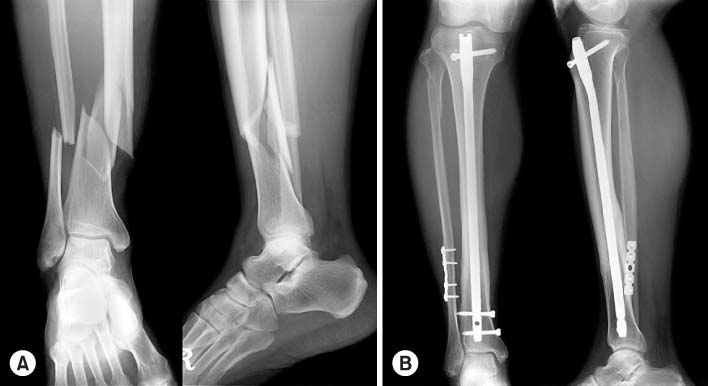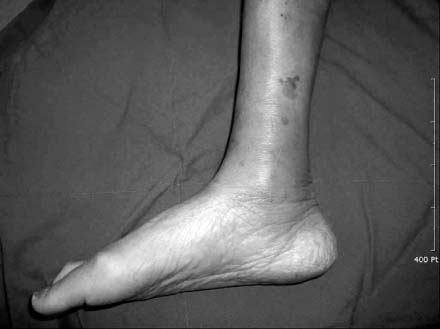Articles
- Page Path
- HOME > J Musculoskelet Trauma > Volume 21(4); 2008 > Article
-
Original Article
- A Comparison between Minimally Invasive Plate Osteosynthesis & Interlocking Intramedullary Nailing in Distal Tibia Fractures
- Kee-Byung Lee, M.D., Si-Young Song, M.D., Duek-Joo Kwon, M.D., Yong-Beom Lee, M.D., Nam-Kyou Rhee, M.D., Jun-Ha Choi, M.D.
-
Journal of the Korean Fracture Society 2008;21(4):286-291.
DOI: https://doi.org/10.12671/jkfs.2008.21.4.286
Published online: October 31, 2008
Department of Orthopedic Surgery, Hallym University Sacred Hospital, College of Medicine, Hallym University, Anyang, Korea.
- Address reprint requests to: Si-Young Song, M.D. Department of Orthopedic Surgery, Hallym University Sacred Heart Hospital, 896, Pyeongan-dong, Dongan-gu, Anyang 431-796, Korea. Tel: 82-31-380-1814, Fax: 82-31-382-1814, sysong@hallym.or.kr
• Received: February 10, 2008 • Revised: June 15, 2008 • Accepted: September 22, 2008
Copyright © 2008 The Korean Fracture Society. All rights reserved.
This is an Open Access article distributed under the terms of the Creative Commons Attribution Non-Commercial License (http://creativecommons.org/licenses/by-nc/3.0/) which permits unrestricted non-commercial use, distribution, and reproduction in any medium, provided the original work is properly cited.
- 604 Views
- 1 Download
- 6 Crossref
Abstract
-
Purpose
- To compare the effectiveness between minimally invasive plate osteosynthesis (MIPO) and interlocking IM nailing in the treatment of distal tibia fracture without involvement of ankle joint retrospectively.
-
Materials and Methods
- 38 patients with distal tibia fracture from Jan. 2004 to Oct. 2005 were divided into two groups. Minimum follow-up was for 12 months. Group MIPO consisted of 18 patients were treated with MIPO and group Nail consisted of 20 patients were treated with interlocking intramedullary nail. The results were compared between two groups by assessing bony union time and operation time. Clinical evaluation was evaluated by Olerud score.
-
Results
- The mean bony union time was 14.4 weeks (12~17 weeks) in group MIPO and 16.7 weeks (13~19 weeks) in group Nail (p=0.011). The mean operation time was 1.05 hours (0.6~1.6 hours) in group MIPO and 0.74 hours (0.4~1.1 hours) in group Nail (p=0.044). The Olerud score was 83.8 (75~100) in group MIPO and was 89.6 (70~100) in group Nail (p=0.075). In Complication, group MIPO showed one metal failure and two skin irritations, group Nail showed three superficial wound infections.
-
Conclusion
- MIPO was the shorter bony union time and the longer operation time than the interlocking intramedullary nailing. There were no significant differences between the two groups in clinical results.
- 1. Asche G. Results of the treatment of femoral and tibial fractures following interlocking nailing and plate osteosynthesis. A comparative retrospective study. Zentralbl Chir, 1989;114:1146-1154.
- 2. Bone LB, Johnson KD. Treatment of tibial fractures by reaming and intramedullary nailing. J Bone Joint Surg Am, 1986;68:877-887.Article
- 3. Chang SA, Ahn HS, Byun YS, Kim JH, Bang HH, Kwon DY. Minimally invasive plate osteosynthesis in unstable fractures of the distal tibia. J Korean Fracture Soc, 2005;18:155-159.Article
- 4. Dehne E. Ambulatory treatment of the fractured tibia. Clin Orthop Relat Res, 1974;105:192-201.Article
- 5. Hahn D, Bradbury N, Hartley R, Radford PJ. Intramedullary nail breakage in distal fractures of the tibia. Injury, 1996;27:323-327.Article
- 6. Helfet DL, Shonnard PY, Levine D, Borrelli J Jr. Minimally invasive plate osteosynthesis of distal fractures of the tibia. Injury, 1997;28:suppl 1. A42-A48.Article
- 7. Im GI, Kim DY, Shin JH, Youn KS, Cho WH. Comparative analysis of interlocking nail and anatomical plate in the treatment of distal tibial fracture. J Korean Soc Fract, 1999;12:632-637.Article
- 8. Krettek C, Stephan C, Schandelmaier P, Richter M, Pape HC, Miclau T. The use of Poller screws as blocking screws in stabilizing tibial fractures treated with small diameter intrameduallary nails. J Bone Joint Surg Br, 1999;81:963-968.
- 9. Na HY, Park YJ, Ko SH, Choi WS, Lee YS, Yoon KD. Comparative analysis of interlocking IM nailing and LC-DCP fixation in the treatment of distal tibial fracture. J Korean Soc Fract, 2002;15:152-158.
- 10. Oh CW, Kyung HS, Park IH, Kim PT, Ihn JC. Distal tibial metaphyseal fractures treated by percutaneous plate osteosynthesis. Clin Orthop Relat Res, 2003;408:286-291.
- 11. Olerud C, Molander H. A scoring scale for symptom evaluation after ankle fracture. Arch Orthop Trauma Surg, 1984;103:190-194.ArticlePDF
- 12. Park KC, Park YS. Minimally invasive plate osteosynthesis for distal tibial metaphyseal fracture. J Korean Fract Soc, 2005;18:264-268.Article
- 13. Song SJ, Cho DY, Yoon HK, Shin DE, Kim JH, Kim TH. Interlocking intramedullary nailing in the distal metaphyseal fractures of the tibia. J Korean Fract Soc, 2005;18:275-280.Article
- 14. Teeny SM, Wiss DA. Open reduction and internal fixation of tibial plafond fractures. Variables contributing to poor results and complications. Clin Orthop Relat Res, 1993;292:108-117.
- 15. Weller S, Hontzsch D, Frigg R. Epiperiostal, percutaneous plate osteosynthesis. A new minimally invasive technique with reference to "biological osteosynthesis". Unfallchirurg, 1998;101:115-121.
- 16. Wyrsch B, McFerran MA, McAndrew M, et al. Operative treatment of fractures of the tibial plafond. A randomized, prospective syudy. J Bone Joint Surg Am, 1996;78:1646-1657.
REFERENCES
Fig. 1
(B) The clinical photo shows the insertion of LCP DMP through subcutaneous tunnel of the distal tibia and fixation of the plate with screws.
(C) Bone union was obtained in 15 weeks after LCP DMP with interfragmentary fixation (AP & Lateral view).

(A) The initial radiographs of 60 year-old female show distal fracture without involvement of ankle joint (AP & Lateral view).

Fig. 2
(B) Bone union was obtained in 16 weeks after interlocking IM nail fixation (AP & Lateral view).

(A) The initial radiographs of 54 year-old male show distal fracture without involvement of ankle joint (AP & Lateral view).

Fig. 3

The patient had a good bone union and excellent function, but complained skin irritation around medial aspect of ankle joint even if we used the Locking Compression Plate Distal Medial Tibia Plate (LCP DMT).

Figure & Data
REFERENCES
Citations
Citations to this article as recorded by 

- Comparative Analysis of Minimally Invasive Plate Osteosynthesis and Intramedullary Nailing in the Treatment of the Distal Tibia Fractures
Ho-Min Lee, Young-Sung Kim, Jong-Pil Kim, Phil-Hyun Chung, Suk Kang, Kaung Suk Jo
Journal of the Korean Fracture Society.2018; 31(3): 94. CrossRef - A Rehabilitation for Ankle Fracture in Korean Medicine: A Report of 4 Cases
Won-Bae Ha, Jong-Ha Lee, Yoon-Seung Lee, Dong-Chan Jo, Jin-Hyun Lee, Jung-Han Lee
Journal of Korean Medicine Rehabilitation.2017; 27(4): 171. CrossRef - Comparison of the Results between Intramedullary Nailing and Plate Fixation for Distal Tibia Fractures
Jung-Han Kim, Heui-Chul Gwak, Chang-Rack Lee, Yang-Hwan Jung
Journal of Korean Foot and Ankle Society.2015; 19(3): 86. CrossRef - Intramedullary Nailing of Distal Tibial Fractures with Percutaneous Reduction by Pointed Reduction Forceps
Jae-Kwang Hwang, Chung-Hwan Kim, Young-Joon Choi, Gi-Won Lee, Hyun-Il Lee, Tae-Kyung Kim
Journal of the Korean Fracture Society.2014; 27(2): 144. CrossRef - A Comparison of the Results between Intramedullary Nailing and Minimally Invasive Plate Osteosynthesis in Distal Tibia Fractures
Chul-Hyun Park, Chi-Bum Choi, Bum-Jin Shim, Dong-Chul Lee, Oog-Jin Shon
Journal of the Korean Orthopaedic Association.2014; 49(4): 285. CrossRef - Analysis of the Result Treated with Locking Compression Plate-Distal Tibia and Zimmer Periarticular Locking Plate in Distal Tibia Fracture
Jun-Young Lee, Sang-Ho Ha, Sung-Won Cho, Sung-Hae Park
Journal of the Korean Fracture Society.2013; 26(2): 118. CrossRef
A Comparison between Minimally Invasive Plate Osteosynthesis & Interlocking Intramedullary Nailing in Distal Tibia Fractures



Fig. 1
(A) The initial radiographs of 60 year-old female show distal fracture without involvement of ankle joint (AP & Lateral view).
(B) The clinical photo shows the insertion of LCP DMP through subcutaneous tunnel of the distal tibia and fixation of the plate with screws.
(C) Bone union was obtained in 15 weeks after LCP DMP with interfragmentary fixation (AP & Lateral view).
Fig. 2
(A) The initial radiographs of 54 year-old male show distal fracture without involvement of ankle joint (AP & Lateral view).
(B) Bone union was obtained in 16 weeks after interlocking IM nail fixation (AP & Lateral view).
Fig. 3
The patient had a good bone union and excellent function, but complained skin irritation around medial aspect of ankle joint even if we used the Locking Compression Plate Distal Medial Tibia Plate (LCP DMT).
Fig. 1
Fig. 2
Fig. 3
A Comparison between Minimally Invasive Plate Osteosynthesis & Interlocking Intramedullary Nailing in Distal Tibia Fractures
Demographics of reported cases
*MIPO: Minimally invasive plate osteosynthesis, †IM nailing: Intramedullary nailing
Olerud score
Results summary
Table 1
Demographics of reported cases
*MIPO: Minimally invasive plate osteosynthesis, †IM nailing: Intramedullary nailing
Table 2
Olerud score
Table 3
Results summary

 E-submission
E-submission KOTA
KOTA TOTA
TOTA TOTS
TOTS



 Cite
Cite

